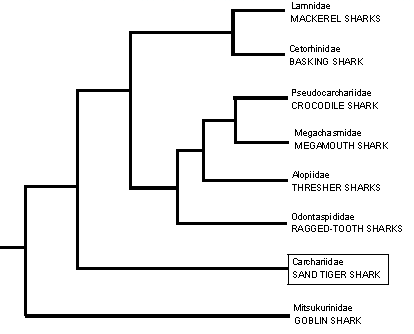Family Carchariidae:
Sandtiger Shark — 1 species

- gill slits fairly large (not extending onto the dorsal surface of the head), all 5 pairs in front of the pectoral fin origin
- eyes relatively small
- tail stalk thick, without lateral keels
- upper precaudal pit present, but no corresponding lower pit
- anal fin broad-based, non-pivoting
- caudal fin asymmetrical, with a relatively short lower lobe
- snout flattened, relatively short (length less than mouth width)
- 3 rows of large anterior teeth
- second dorsal fin about as large as the first, originating closer to the pelvic fin bases than to the pectoral fin bases
- coastal regions of eastern and western Atlantic, western Pacific, and Indian (off western Australia and eastern South Africa) oceans

Sandtiger Shark (Carcharias taurus)
Until recently, the Sandtiger Shark (Carcharias taurus) was considered to be a member of the same family as the ragged-tooth sharks (Odontaspididae). Although the Sandtiger shares many features with the odontaspidids, some morphological differences are apparent. Experts differ in their interpretation of how significant these differences are and how the Sandtiger is related to the ragged-tooth sharks.
The Sandtiger Shark has had a rather tangled taxonomic history, undergoing numerous changes of genus: from Carcharias to Triglochis to Odontaspis to Eugomphodus. For many years, following a 1965 ruling by the ICZN (the academic body which presides over the taxonomic names to be used for all formally-described animals), the Sandtiger was considered to be congeneric with the ragged-tooth sharks, and thus they were all lumped under the genus Odontaspis. Leonard Compagno argued tirelessly against the taxonomic 'lumpers', crusading to have the Sandtiger placed back in its original genus, Carcharias, to denote its distinctness from the superficially similar ragged-tooths of the genus Odontaspis. In 1987, the ICZN finally ruled in his favor, re-establishing Carcharias as the officially-sanctioned genus. Naylor et al.'s (1997) comparative study of mtDNA sequences of lamnoid sharks strongly suggests that Compagno — rather than being a radical revisionist — was, if anything, too cautious in defending the distinctness of the Sandtiger: the molecular genetics data not only support that Carcharias and Odontaspis are distinct genera, but that they represent separate lineages that almost certainly warrant distinct families as well.
The lineage of the Sandtiger Shark extends back almost as far as that of the Goblin Shark, to about 112 to 97 million years ago. The earliest known representative of the Sandtiger's lineage is Carcharias striatula, whose fang-like fossilized teeth are very similar to those of its living descendent. Its ancient origin marks the Sandtiger as one of the lamnoids longest-running success stories and suggests that its dentition — and possibly body form — may be similar to the common ancestor of the entire group. A possible second extant species of Sandtiger, the Indian Sandtiger (Carcharias tricuspidatus) was described in 1878 by British ichthyologist Francis Day, based on a dried skin from India. This skin has long since been lost and, given that no additional specimens clearly assignable to this species have been captured, it seems best to consider it a species dubium for the time being.
- More about the life history and behavior of the Sandtiger Shark
